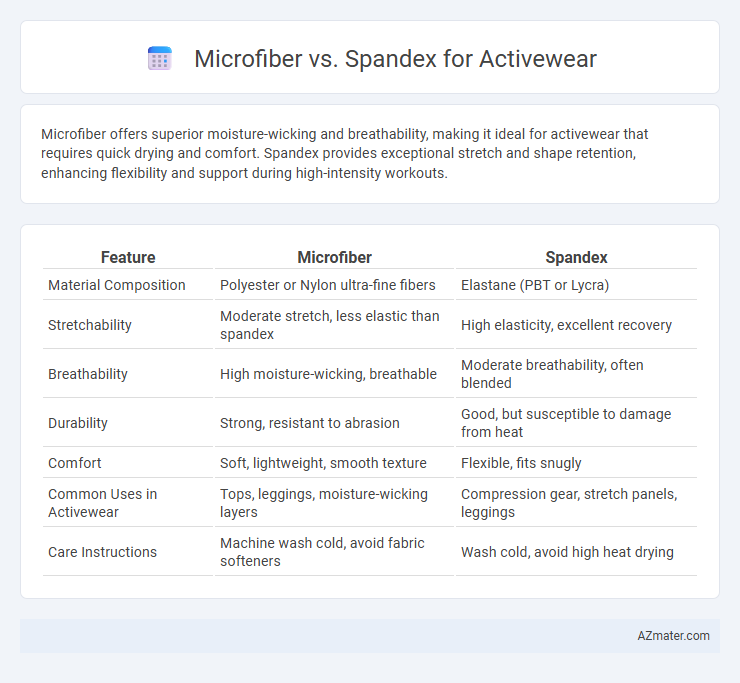Microfiber offers superior moisture-wicking and breathability, making it ideal for activewear that requires quick drying and comfort. Spandex provides exceptional stretch and shape retention, enhancing flexibility and support during high-intensity workouts.
Table of Comparison
| Feature | Microfiber | Spandex |
|---|---|---|
| Material Composition | Polyester or Nylon ultra-fine fibers | Elastane (PBT or Lycra) |
| Stretchability | Moderate stretch, less elastic than spandex | High elasticity, excellent recovery |
| Breathability | High moisture-wicking, breathable | Moderate breathability, often blended |
| Durability | Strong, resistant to abrasion | Good, but susceptible to damage from heat |
| Comfort | Soft, lightweight, smooth texture | Flexible, fits snugly |
| Common Uses in Activewear | Tops, leggings, moisture-wicking layers | Compression gear, stretch panels, leggings |
| Care Instructions | Machine wash cold, avoid fabric softeners | Wash cold, avoid high heat drying |
Introduction to Microfiber and Spandex
Microfiber is a synthetic fiber finer than one denier, known for its exceptional softness, moisture-wicking properties, and durability, making it ideal for activewear that demands comfort and breathability. Spandex, also called elastane or Lycra, offers unmatched stretch and recovery, providing flexibility and support essential for high-performance athletic activities. Combining microfiber with spandex enhances activewear by delivering a lightweight, breathable fabric with superior elasticity and shape retention.
Fabric Composition and Structure
Microfiber activewear is composed of ultra-fine synthetic fibers such as polyester or nylon, which are densely woven to enhance moisture-wicking and breathability. Spandex, also known as elastane or Lycra, is a synthetic fiber known for its exceptional elasticity, often blended with other fabrics to provide stretch and shape retention. The combination of microfiber's fine, smooth structure with spandex's stretchable properties results in activewear that offers both comfort and performance.
Moisture-Wicking Properties
Microfiber fabrics excel in moisture-wicking due to their fine fibers that enhance breathability and quick-drying capabilities, making them ideal for intense workouts. Spandex, while known for its stretch and flexibility, typically offers less effective moisture management on its own but is often blended with microfiber to improve moisture control and comfort. Choosing activewear with a higher microfiber content ensures superior sweat absorption and faster evaporation during physical activities.
Breathability and Airflow
Microfiber fabrics excel in activewear by providing superior breathability and efficient moisture-wicking properties, promoting optimal airflow and keeping the skin dry during intense workouts. Spandex offers excellent stretch and flexibility but tends to have lower breathability, often trapping heat and moisture close to the body. Combining microfiber with spandex blends enhances airflow and comfort by balancing breathability with elasticity for high-performance athletic wear.
Stretchability and Flexibility
Microfiber activewear offers superior moisture-wicking properties and durability but generally provides less stretch compared to spandex, making it ideal for light to moderate activities. Spandex, known for its exceptional elasticity, allows for maximum stretch and flexibility, supporting a full range of motion during high-intensity workouts and yoga. Blending microfiber with spandex creates a fabric that combines breathability and comfort with optimal stretchability, enhancing performance and wearability in activewear.
Comfort and Skin Sensation
Microfiber fabrics offer superior breathability and moisture-wicking properties, making them exceptionally comfortable for prolonged activewear use by keeping skin dry and cool. Spandex provides unmatched elasticity and shape retention, enhancing skin sensation through a snug, second-skin fit that supports dynamic movement without restriction. Combining microfiber with spandex often results in activewear that balances softness, stretch, and ventilation for optimal comfort during physical activity.
Durability and Longevity
Microfiber activewear excels in durability due to its tightly woven synthetic fibers that resist abrasion and maintain shape after multiple washes. Spandex provides exceptional elasticity and recovery but may degrade faster under frequent stretching and exposure to heat. Combining microfiber with spandex blends enhances longevity by balancing stretch with sustained structural integrity.
Care and Maintenance
Microfiber activewear requires gentle washing in cold water and air drying to maintain its moisture-wicking properties and prevent fabric pilling. Spandex garments need careful handling to avoid high heat exposure during washing and drying, as excessive heat can degrade elasticity and cause fabric breakdown. Both materials benefit from mild detergents, avoiding bleach and fabric softeners, which can compromise fiber integrity and performance.
Environmental Impact
Microfiber activewear, typically made from synthetic polyester or nylon, poses significant environmental challenges due to its non-biodegradable nature and the release of microplastics into water systems during washing. Spandex, also a synthetic fiber, shares similar issues but often appears in smaller proportions blended with other fabrics, which can complicate recycling efforts and extend garment decomposition times. Choosing sustainable alternatives like recycled polyester or bio-based spandex reduces carbon footprint and pollution in the production and disposal stages, enhancing eco-friendly activewear options.
Choosing the Right Fabric for Your Activewear
Microfiber offers moisture-wicking properties and breathability, making it ideal for high-intensity workouts where sweat management is crucial. Spandex provides exceptional stretch and flexibility, enhancing comfort and freedom of movement during activities requiring dynamic motion. Balancing microfiber's durability and spandex's elasticity helps create activewear tailored for both performance and comfort.

Infographic: Microfiber vs Spandex for Activewear
 azmater.com
azmater.com